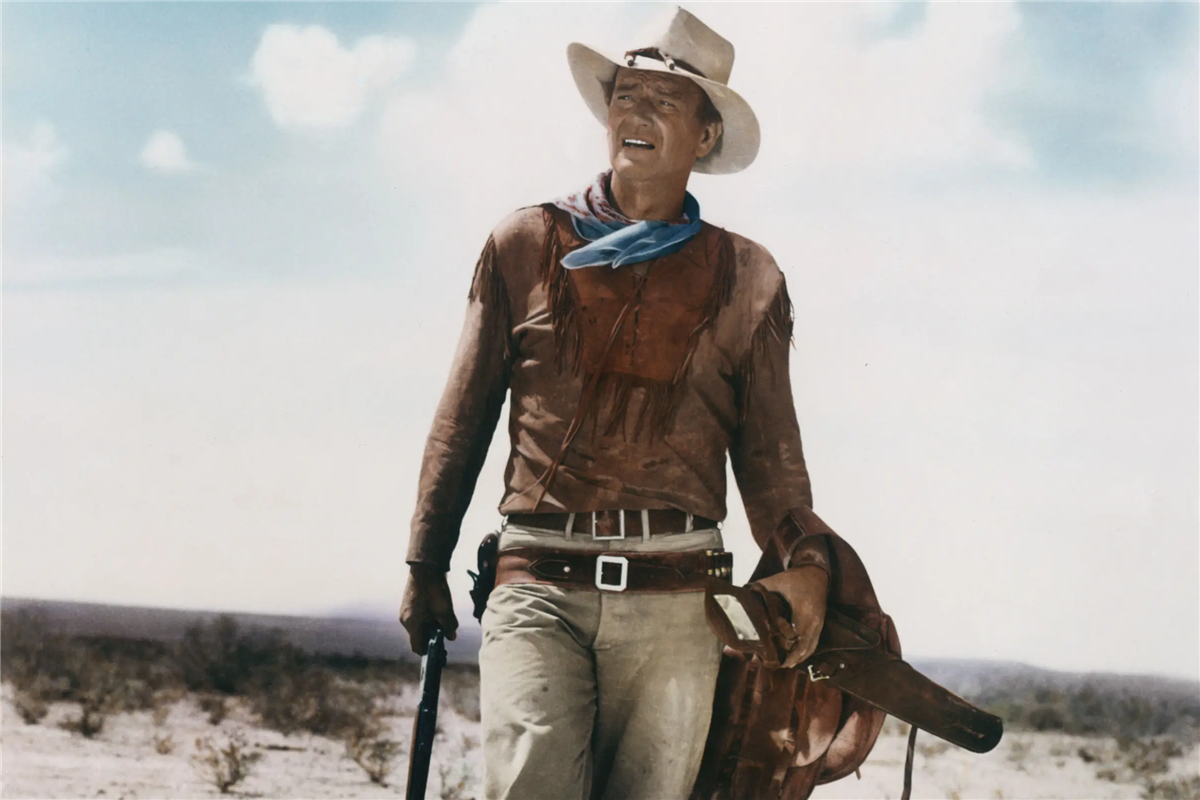Hondo(1953), starring John Wayne and Geraldine Page, shows some new dimensions of Duke as a star and actor, but still, the film remains a quintessential John Wayne Western.
“Women always figure every man who comes along wants ’em.”
A typical John Wayne line delivered in the typical John Wayne style by John ‘Duke’ Wayne. The film is Hondo(1953), and Duke is Hondo Lane, a part Native American – or maybe just a white man raised by the natives – army scout and dispatch rider; and he is talking to Geraldine Page‘s Mrs. Angie Lowe, a frontier woman. Lowe’s husband, Ed (Leo Gordon), has been gone for some time (most probably abandoned her), and she has been left to fend for herself and their young son, Johnny (Lee Aaker). When Hondo drifts in to her ranch and inquires about her husband, Angie makes some unconvincing excuses for her husband’s absence, stating that he is out rounding up some loose cattle on the nearby mountain, but Hondo is experienced enough to see through her lies; he realizes that she has cooked up this story since she is wary of him; that he might make sexual advances on her. This is the moment when Wayne delivers the above line, which leaves Mrs. Lowe all embarrassed and perhaps a little insulted. Soon enough, we find Mrs. Lowe all dressed up and made up, looking exquisitely beautiful- a far cry from the weary housewife we met at the beginning. She starts following the mysterious stranger around the ranch, keenly observing his activities.
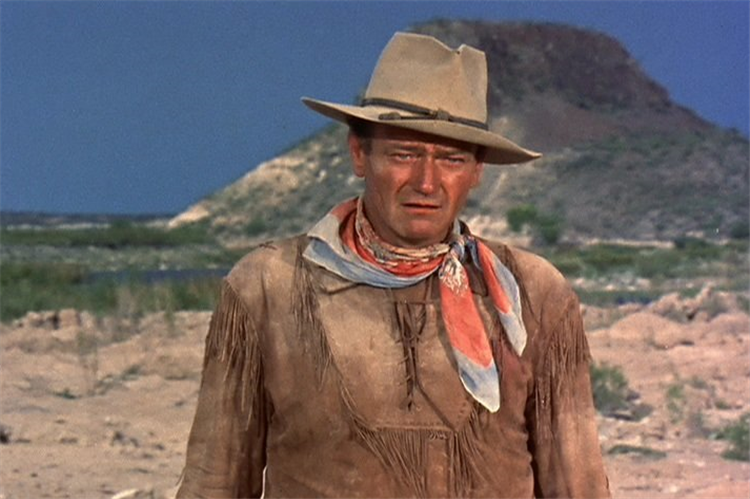
The first 25 minutes of Hondo plays very differently from any other John Wayne movie, at least any John Wayne western anyway. It deals mostly with Wayne’s Hondo bonding with this frontier housewife, Angie played by Page and her son Johnny. there are no fistfights or gunfights or even hints of conflict, except a mention of an Apache rising, which is never seen on screen; and about which Hondo keeps talking about. What it has is a strong feel of romantic sensuality (and undertones of sexual tension), as the virile stranger gets closer and closer to the timid, yet feisty housewife who is very conflicted about her feelings for him. She is wary of letting him into the house (and her heart), but has difficulty in letting him go either. This portion plays out like Duke’s ‘The Bridges of Madison County‘ and this is the most romantic, the most sensitive, tender and most subtle he has ever been in a Western (with the exception of John Ford’s Rio Grande maybe, where he teamed up with Maureen O’Hara). Look at the scene where the two bond by talking about the sense of smell. Hondo says that Natives can track white folks purely based on their smell. Angie contests this and says its impossible. To this Hondo retorts:
“No, it isn’t impossible, Mrs. Lowe. You baked today. I can smell fresh bread on you. Sometime today, you cooked with salt pork. Smell that on you, too. You smell all over like soap: you took a bath. And, on top of that, you smell all over like a woman. I could find you in the dark, Mrs. Lowe, and I’m only part Indian.”

I don’t know how today’s audience would respond to this, but i find this to be one of the most moving moments in movies. It’s not just the words, but also the performances of the actors, Wayne’s of course is great, he has a great way with lines like these, but it is Geraldine Page who mainly score in this scene: Her body language, her subtle reaction when Wayne gets close to her and those side ward glances; she expresses a hell of a lot without speaking much in the scene. This was Page’s film debut. She was a an accomplished Broadway actress before this, and a method actress to boot; the kind that John Wayne despises. But just like Montgomery Clift turned out to be the perfect foil for Wayne in Red River, Page turned out to be perfect (for this role) and Wayne in this film. She develops the character much much more deeply than what is written (and what a traditional film actress would have). She gives the character strength and personality, strong enough to steal scenes even from Wayne in some instances. Not surprisingly, she won an Oscar nomination for her performance in this film. The scene also gives an idea of what kind of a film this is. Like many a quintessential John Wayne film, this has to be watched with your heart rather than the head.
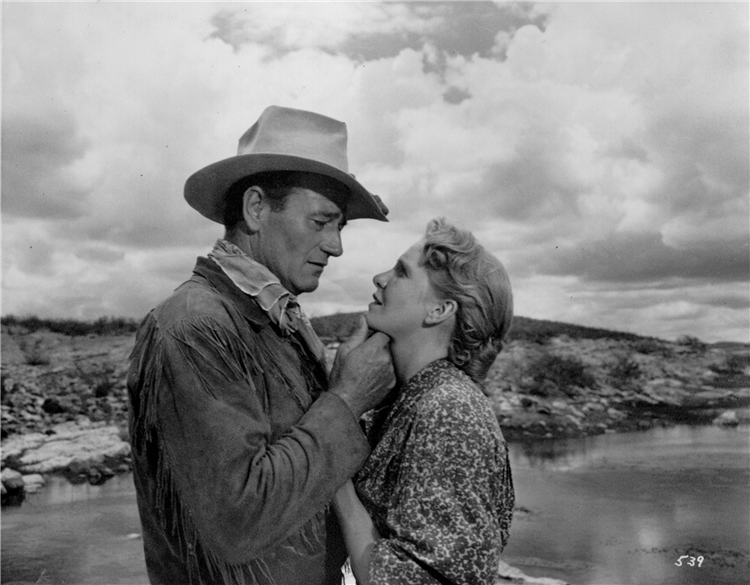
Hondo is also the most domesticated John Wayne we have ever seen. Hondo gradually becomes a surrogate father and husband to Johnny and Angie: helping out with the household chores; chopping wood, breaking in horses and teaching Johnny swimming and fishing. But the emotional depth of his character goes even deeper. Soon, we get to know that Hondo is a widower; that he had an Apache wife who died; and he is attracted to Angie mainly because she reminds him of his dead wife. Angie contest this comparison, saying that an Apache girl would not look anything like her. Hondo’s response again brings out the romantic, tender side of Wayne to the fullest. He goes in to a lengthy monologue into what Destarte – his late wife’s name- stands for an finally ends it with
“I didn’t mean that. I got a bad habit of tellin’ the truth, but being pretty isn’t much. I know a lot of pretty people I wouldn’t trust with a busted nickle-plated watch. But some others, somethin’ comes outa the inside of ’em and you know you can trust ’em. Destarti had that. And you’ve got it too.”
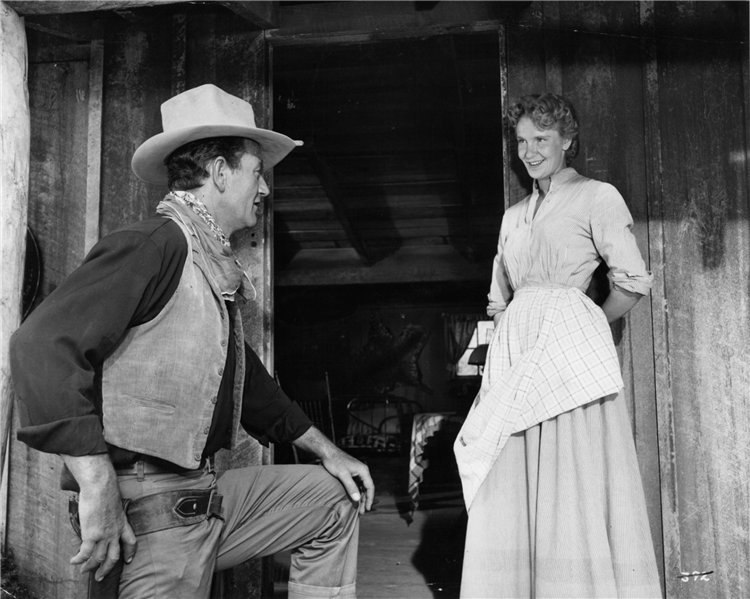
And then he takes Angie in to her arms and kisses her. She doesn’t seem to protest, just simply says that she is a married woman. Hondo has a classical John Wayne retort to that too
“I thought about that too, But a long time ago, I made me a rule. I let people do what they want to do.”
And saying this he bids goodbye and rides away on the horse that he purchased from Angie. This ends the first act I mentioned, which is about 25 minutes of this crisp and lean 84 minute movie . Hondo and Angie wouldn’t meet again for another half hour of the film.
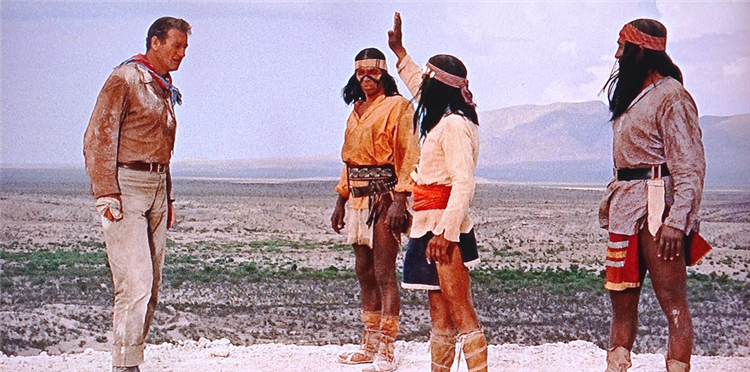
As untypical as Wayne comes across in this first act, Hondo is still the quintessential John Wayne Western. As the film progresses into its second and third act, we get all the expected ingredients: Fist-fights, Knife fights, Gun Fights, Cavalry charges, regular co-stars like Ward Bond and a pre-Gunsmoke James Arness; and lot of classic Wayne one liners. Hondo Lane is also the archetypal Western hero, which is established in the opening shots of the film itself: A stranger, accompanied by a feral dog, is seen walking towards an isolated ranch in the Arizona desert. An image that we have seen in countless western movies including Shane (that was released in the same year and with which the film shares several similarities), The Searchers etic …. The only difference is that he is walking (and not riding a horse), with his saddle bags in one hand and a rifle in the other. It’s later resealed that Lane’s horse was killed when he was attacked by Apaches a few days earlier, and he’s been on foot ever since. This seems to be a nod to Duke’s iconic entrance in his star making role of Ringo Kid in Stagecoach
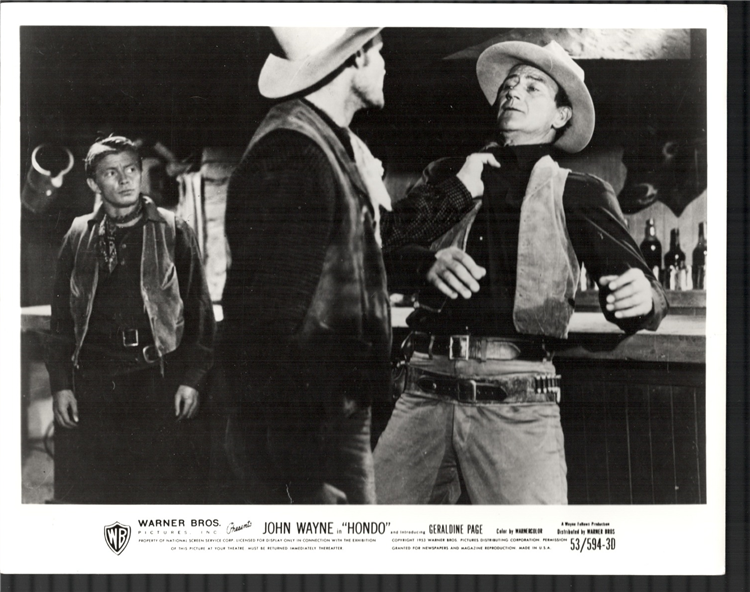
This was John Wayne’s maiden production through his production company that later morphed into Batjac. This was also his return to the western genre (that made him the biggest star in the industry) after an absence of three years. So he was fully involved in the creation of this character and movie. The screenplay is by James Edward Grant, Wayne’s close friend and regular writer, whose brand of terse , snappy dialogue was tailor made for Wayne. Theirs was perhaps the first of the Actor -writer collaborations, where the writer would be an expert in writing dialogue to suit the star’s unique Line reading style. In future there would be Jack Nicholson & Robert Towne or Robert Redford & David Rayfiel. I have waxed eloquently about how much i like Wayne’s line readings in previous posts on Red River and Rio Bravo. This film also does not disappoint. Apart from the lines that i have already mentioned, Grant has crafted some typical John Wayne lines for the star, which he delivers in his inimitable style . Sample this:
Civilized?, Gentleman?, awful lot for one day
Everybody gets dead. It was his turn.
I don’t guess people’s hearts got anything to do with a calendar.
On Speaking the truth: It’s The measure of a man
On west point recruits :Partly they learn, partly they die. But I gotta float my stick same as you, I never saw one of ’em I had to be ashamed of.
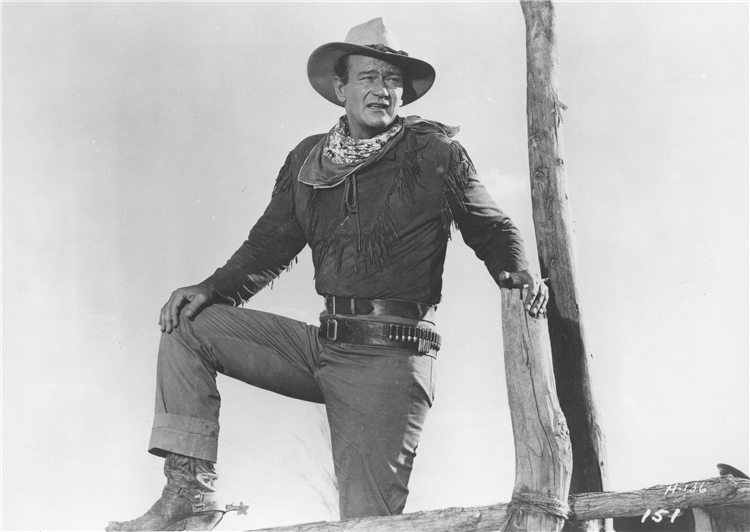
The film also paints a sympathetic portrait of the American Natives. Hondo asks Angie to pack up and leave for safety as the Apaches are on the warpath, but she says that we are on good terms with them and we have a treaty. Wayne says that ‘We’, the whites have broken the treaty; we have lied to them and there is no term for lie in Apache language, and hence, they are going to come hard at the settlers; the main conflict in the film is in regards to this. Vittorio, the reasonable Apache chief, adopts Johnny into the Apache tribe thus allowing Angie and Johnny to continue living in the ranch. Meanwhile, Hondo kills Angie’s real husband in a skirmish. Hondo is mistaken for Angie’s husband by Vittorio ,who has been forcing Angie to take a husband to help her raise Johnny. Angie lies to save Hondo’s life and thus a wounded Hondo, who was hurt in a knife fight with Silva – Vittorio’s second in command, lands back at Angie’s ranch. Their romantic tryst that was left off after the first act renews and Angie confesses her love for him. But soon she finds out that Hondo has killed her husband, but that does not change her affections for him, as she reveals that her husband was a cad, and a drunkard, who was constantly unfaithful to her; who married her only for the ranch and then abandoned her. Thus, Hondo and Angie’s love story has a happy ending, with Hondo using an Apache term ‘Varlabania‘ – that is used during Apache marriage ceremony – which means ‘Forever’ to seal their relationship.
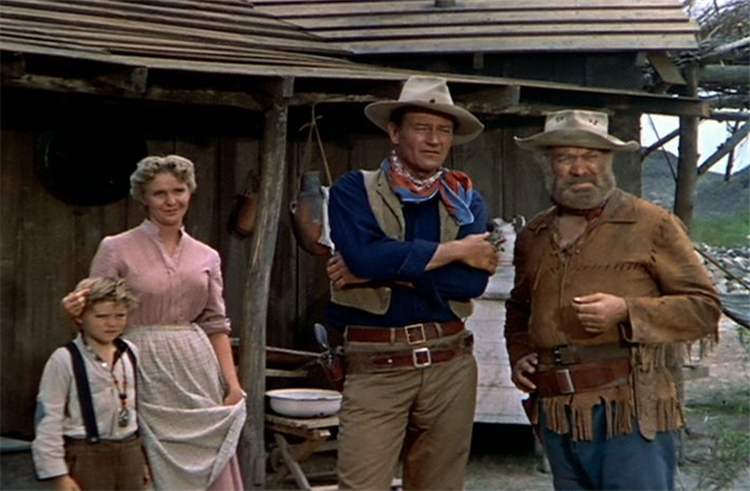
We also get a nod to Fort Apache, when a cocky west point graduate sergeant – in the mold of Henry Fonda in that film – arrives to take on the Apaches. He dismisses Hondo’s words of wisdom; he takes his men into battle, only to return defeated and badly injured, and to be tended by Angie. Finally, Angie decides to leave the ranch with Johnny and go with Hondo to to his ranch in California. On their way, they are attacked by a band of Apaches led by Silva, who is now the Apache chief after Vittorio’s death. But the Apaches are defeated, as Hondo ruthlessly kills Silva in the same way Silva killed Hondo’s dog. The sergeant informs Hondo that a new batch of troops are arriving to deal with Apaches. Hondo knows what this means. It’s going to be the end of the Apaches. As someone who has a strong bond with the Apache culture, he feels the pain of this loss which is evident in the words that closes the film:
“End of a way of life. Too bad. It was a good way.”

The film was shot in 3-D which was quite a rage in the early fifties. Along with Hitchcock’s Dial M for Murder, this film has the best use of this technology. For some years Hollywood had been suffering a decline in viewership, partly due to the advent of TV, and of all the great stars, only Wayne remained immune. His films were still guaranteed earners and all the major studios either concentrated on him, or came up with gimmicky ideas to draw people back to the cinema. One of the gimmicks they turned to was 3D, and even Duke decided to try it on Hondo. Despite his pulling power and his track record, he never took success for granted. He was innovative and determined to hold onto his place, and if gimmicks were the way forward, he had to be on the front line; fighting with everything at his disposal has always been Duke’s motto. Even then, there are very few gimmicky 3-D shots in the film, like the thrusting of knives and spears .The director John Farrow mainly used it to give depth to the beautiful desert landscape, and I guess Wayne would have looked particularly imposing in 3-D, especially in moments when he is walking towards the camera in the opening shots; though Duke doesn’t need such extra dimensions to assert himself on screen. Duke was going through a difficult period in his personal life during the making of the film: He was undergoing a messy divorce from his second wife and he disliked the film’s director John Farrow. On top of that, filming in 3-D proved to be difficult, it required many more takes than normal, delays tended to be longer and equipment often broke down. Worse, by the time the film released, 3-D was on the wane and the film was released mostly in the ‘flat’ format, but still the film was a box office hit.
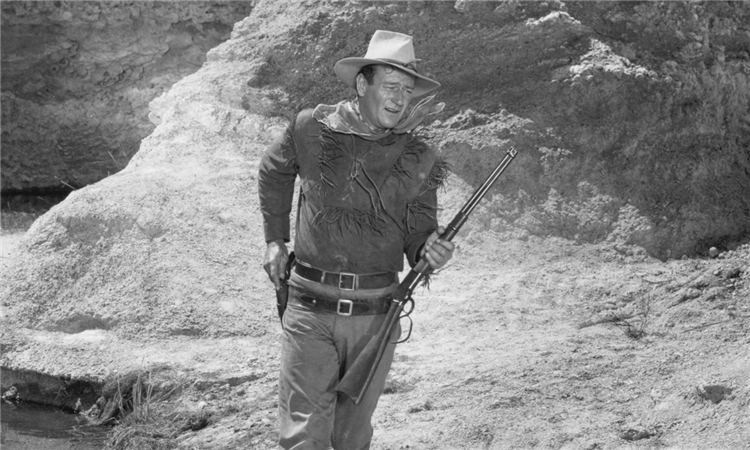
Hondo is not spoken off as often as The Searchers, Stagecoach or Red River, mainly because the film does not have the sweep and greatness of those films. But this is a vintage John Wayne film and a very good Western, where we get to see John Wayne adding extra dimensions to his screen persona, even if one discount the 3-D.
